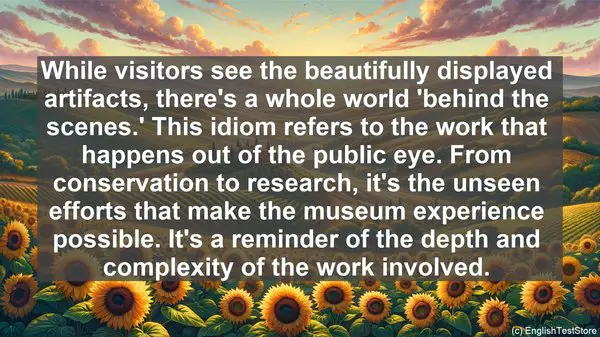Introduction: The Power of Idioms
Hello, students! Today, we’re diving into the fascinating world of English idioms. These expressions, unique to the language, add color and depth to our conversations. For museum technicians and conservators, understanding and using idioms is particularly important. It not only showcases your language skills but also helps you connect with colleagues and understand the nuances of the field. So, let’s get started!
1. ‘In the same boat’
Imagine you’re working on a challenging restoration project with a colleague. You encounter a setback, and it’s easy to feel discouraged. But, if your colleague says, ‘Don’t worry, we’re in the same boat,’ it instantly reassures you. This idiom means that you’re facing a similar situation, and you’re in it together. It’s a reminder that you’re not alone in the challenges you encounter.
2. ‘A labor of love’
Conservation work isn’t just a job; it’s a passion. When you spend hours meticulously restoring an artifact, it’s more than just work; it’s a labor of love. This idiom encapsulates the dedication and emotional investment that goes into your craft. It’s a beautiful way to describe the deep connection you have with your work.

3. ‘Dot your i’s and cross your t’s’
Attention to detail is crucial in the world of museum conservation. Every step, from documentation to restoration, requires precision. The idiom ‘dot your i’s and cross your t’s’ emphasizes the importance of being meticulous and thorough. It’s a reminder to double-check and ensure that nothing is overlooked.
4. ‘The devil is in the details’
While ‘dot your i’s and cross your t’s’ focuses on being meticulous, ‘the devil is in the details’ highlights the potential challenges and complexities that lie within those details. It’s a reminder that even the smallest aspects can have significant implications. This idiom encourages you to pay attention to every element, no matter how seemingly insignificant.
5. ‘A picture is worth a thousand words’
In the field of conservation, visual documentation is often as important as written records. This idiom emphasizes the power of visuals. A single image can convey information, context, and even emotions more effectively than words. It’s a reminder of the value of visual documentation in preserving and understanding artifacts.
6. ‘On the same page’
Collaboration is key in the museum world. When working with a team, it’s crucial to be ‘on the same page.’ This idiom means that everyone has a shared understanding and is working towards the same goal. It ensures that there’s no miscommunication or conflicting directions, leading to a more efficient and cohesive team.
7. ‘Behind the scenes’
While visitors see the beautifully displayed artifacts, there’s a whole world ‘behind the scenes.’ This idiom refers to the work that happens out of the public eye. From conservation to research, it’s the unseen efforts that make the museum experience possible. It’s a reminder of the depth and complexity of the work involved.
8. ‘In the pipeline’
When discussing upcoming projects or initiatives, you might use the idiom ‘in the pipeline.’ It means that something is being planned or developed and will be implemented in the future. It’s a way to indicate that there are exciting things on the horizon, creating anticipation and enthusiasm.
9. ‘On the fence’
In the decision-making process, you might find yourself ‘on the fence.’ This idiom means that you’re undecided or unsure about something. It’s a way to express that you’re weighing the options and haven’t reached a conclusion yet. It’s important to communicate this effectively to ensure that decisions are made with careful consideration.

10. ‘Think outside the box’
In the ever-evolving museum field, innovation is key. The idiom ‘think outside the box’ encourages creative thinking and problem-solving. It means to approach a situation from a fresh perspective, considering unconventional ideas. It’s a reminder to embrace creativity and not be limited by traditional methods.
Conclusion: Mastering the Idioms
These 10 idioms are just the tip of the iceberg. English is rich with expressions that can enhance your communication skills. As you progress in your studies or career, continue exploring and learning new idioms. They not only make you a more effective communicator but also provide insights into the language and culture. So, embrace the world of idioms, and let your language skills shine!
